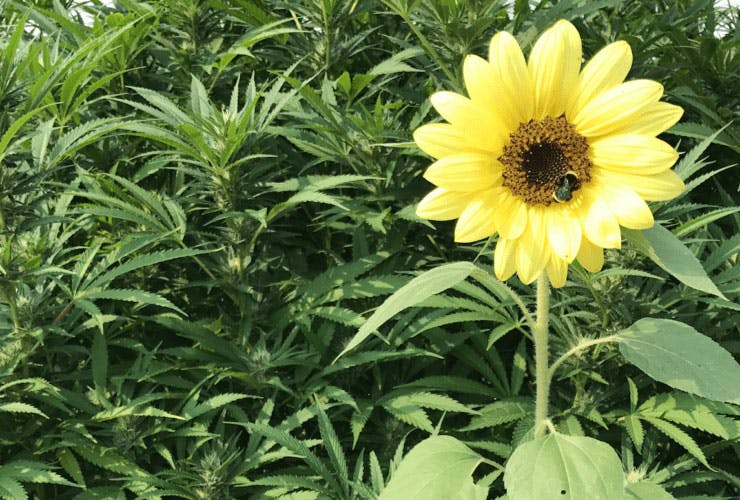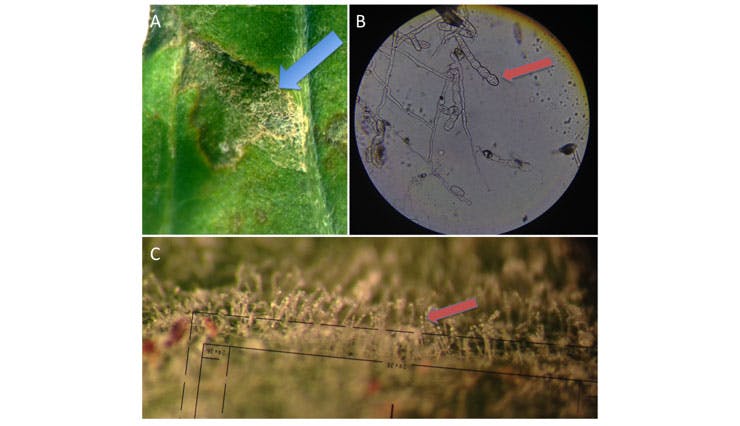
As the temperatures cool, days shorten, buds swell, and clouds return, so do many dreaded foes, including powdery mildew. Powdery mildew fungi (in the family Erysiphaceae) are obligate parasites to over 10,000 different vascular plant species. Being an obligate parasite means they cannot complete their life cycle without a specific, suitable, and living host. Despite being ubiquitous, powdery mildews remain fairly host-specific, so you probably don’t have to panic over every powdery mildew infection you come across near your grow.
In general, relatively cool atmospheric conditions, moderate temperatures, and reduced light (shade) are favorable to powdery mildews. Contrary to other fungal pathogens, free-water is not required for infection and can actually inhibit powdery mildew spore germination (presumably due to excessive turgor pressure). What does this all mean? It means temperature, humidity, and daylight (or artificial light) are more correlated with powdery mildew outbreaks as opposed to water. When it rains, it’s more critical to watch for diseases like bud rot, caused by the fungus, Botrytis cinerea.
So what’s this powdery mildew (or as the industry calls it, PM) stuff do anyway? Powdery mildew infections are localized, superficial, white powdery patches on plant tissue (most often, leaves). These white patches form dedicated invasive infection structures, called haustoria, that leech the nutrients from the plant cells they are in direct contact with. The powdery-like substance that’s on your plant is typically a mix of the mycelium, structures that produce asexual spores, and the asexual spores themselves. As winter approaches, you may also find black spots (sexual fruiting bodies called cleistothecia) interspersed in the powdery mycelium.
It’s easy to recognize powdery mildew as it is quite conspicuous, though it can resemble mineral deposits to the untrained eye. To differentiate the two, consider recent weather events, your spray schedule, and your nutrient applications; if necessary, pick up a magnifying glass or a cheap dissecting microscope and look for the chain-produced asexual spores and tube-like mycelium on the surface of the leaf (see Figures 1A, 1B, and 1C for micro and macro images of one of the powdery mildew species that infect Cannabis).

Figure 1. A. An early PM infection; notice the fuzzy white growth. B. Powdery mildew asexual reproductive structures (called conidiophores) and their spores (called conidia, red arrow). C. An infected leaf under 15x magnification. Notice the chains of conidia as indicated by the red arrow. All images are originals taken by Michele Wiseman.
Contrary to popular belief in the Cannabis industry, powdery mildew infections are not systemic as they do not travel throughout the vascular tissue to produce new infections elsewhere in the same plant. Occasionally, you may see necrotic (i.e. dying) tissue adjacent to a powdery mildew infection and a heavy infection will significantly reduce your plant’s vigor. Moreover, heavy outbreaks may weaken the plant and increase chances of secondary pathogen infections or pest infestations. Sometimes, outbreaks in confined spaces (such as warehouses or greenhouses) result in the rapid movement of infections on and across individual plants due to the air dispersal of asexual spores (often from circulating fans). In this sense, it may LOOK like a systemic infection, but in reality, air movement is just dispersing spores around your grow space.
Fortunately, with diligence, it is entirely possible to prevent massive PM outbreaks. The PNW Plant Disease Handbook thoroughly discusses the most common and effective cultural, biological, and chemical controls. If you decide to utilize fungicides permitted for use on Cannabis, be sure to follow the R.U.L.E.S. as powdery mildew is considered a high-risk pathogen with regard to fungicide resistance (from the PNW Plant Disease Handbook):
- R = Rotate or mix fungicides of different groups.
- U = Use labeled rates and at times of critical disease control.
- L = Limit total number of applications of any fungicide group in a given growing season.
- E = Educate yourself about fungicide groups and resistance management tactics.
- S = Select fungicides that have multiple sites of activity (such as groups M1, M2, M3, etc…).
In the case of massive outbreaks, thorough clean up of your growing space is necessary to prevent future infections. For indoor or greenhouse grows, the most effective strategy is to clear out all plant material and treat pots and surfaces with a surface disinfectant or sulfur bomb (according to the label instructions). If this is not possible, one could heat up the growing space to 40°C (104°F) for six hours to kill all powdery mildew inoculum (also kills mites; two birds one stone). Be sure to examine and treat any new plant material entering the newly sanitized growing space to maintain a PM-free zone. For major outbreaks outside, follow the PNW Plant Disease Handbook management suggestions or, if feasible, consider moving your grow to a different location as PM can remain dormant on any residual infected plant debris.
—
For more information on powdery mildew and management of other Cannabis pathogens, I recommend checking out the only (currently available) comprehensive, peer-reviewed, and scientifically rigorous book on Cannabis pathogens, “Hemp Diseases and Pests” by J.M. McPartland, R.C. Clarke, and D.P. Watson.
Michele Wiseman is a plant pathologist specializing in diagnostic and molecular testing for agricultural crops such as hazelnut, blueberry, and ornamentals. You can contact her at michele@mjdiagnostics.com.